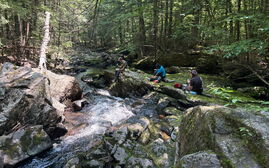As ATV use grows, report recommends rules to maintain economic boost
 Courtesy / Maine Department of Inland Fisheries & Wildlife
A state task force has come up with recommendations on ATV trail use and maintenance in the state.
Courtesy / Maine Department of Inland Fisheries & Wildlife
A state task force has come up with recommendations on ATV trail use and maintenance in the state.
More Information
Recommendations by a task force created by Gov. Janet Mills aim to wrangle the growing popularity of ATVs, which are getting bigger and more powerful, weighed against the concerns of landowners and the economic boost the recreational activity brings to the state.
Maine’s All-Terrain Vehicle Trail Initiatives task force this week released a 33-page report with six major recommendations and next steps, including major fee hikes. The group, made up of ATV riders, land and business owners, and government stakeholders, was asked by Mills to address opportunities and issues associated with increasing registrations of the vehicles.
As ATVs get bigger and their use becomes more widespread, recommendations would limit size, increase fees, strengthen trail maintenance rules and give landowners more say. While the trail network is state-supported, largely with grants to ATV clubs, more than 80% of the state's 6,015-mile trail system is on private land. The system is overseen by the Maine Department of Inland Fisheries & Wildlife.
“The rising popularity of ATVs provides many economic benefits to towns and business throughout the state, particularly in rural Maine," said Mills in a news release. She said the economic benefit "is why it is critical that we implement a collaborative strategy that supports that growth, assists landowners in managing it and continues to foster Maine’s tradition as a premier outdoor recreation destination.”
One of the most significant recommendations is to increase fees to boost trail maintenance and education. Deterioration of trails, behavior and the resulting deterioration of landowner goodwill will end up hurting the state's economy, the report says.
"The task force heard numerous public comments related to Maine being an ATV riding destination," it says. "ATV riding in Maine by non-residents has grown significantly over the past 15 years, and many towns in rural Maine receive a considerable economic boost to their local businesses by catering to both resident and non-resident ATV riders."
The report said to keep the economic impact growing, while maintaining the network of trails, will require a increase in funding.
Continuing issues
There are more than 70,000 ATVs registered in the state. While no economic impact statement came with the report, a report by the University of Maine for a similar effort from 2003 to 2006 estimated $156 million of spending in 2003-04 by users of 59,000 licensed ATVs. That report was done as the Gov. John Baldacci administration looked to increase the trail system from 2,000 to 7,000 miles to help protect landowners from off-roading and harness economic benefits.
The effect on private land is still an issue, despite the increase of trails, according to the new report.
"Maine enjoys a unique spirit of mutual generosity and respect between landowners and users and a long-standing tradition of open access," the report says. "But often, the only benefit to private landowners who allow recreation is a feeling of community and being a good neighbor. Meanwhile, ATV riding has grown in popularity and ATV design has evolved to include several different sizes, widths, weights, and horsepowers. The potential impact of these larger vehicles on the trails has raised concerns among landowners and ATV riders alike."
The task force acknowledges ATV clubs do a lot of maintain trails, but also says, "Land abuse costs real money and exposes us to liabilities and safety risks that we can’t justify — financially or ethically. And on a systemic level, lack of funding for trail maintenance and lack of structure, oversight and inability to control who can use our land are current and pressing concerns"
Six recommendations
The report says that other issues cropped up during the four months of study, which included input from more than 1,000 people and organizations, and more work will have to be done. Adopting next steps range from state to club action, and the process is varied. But the group made the following initial recommendations.
Limiting size. There are no limits on size and weight for ATVs that use the state trail system, which was built for 50-inch wide vehicles. As vehicle size and horsepower has increased, and the use of side-by-side ATVS become more common [seats two to six people], some landowners have set 60-inch limits on trails. Concerns are bigger vehicles damage land and the environment, as well as bridges and other infrastructure.
The lack of clarity leads to confusion, frustration and a disjointed trail system, the report says, and the 65-inch, 2,000-pound limit is a compromise "It is clear there is a limit to the size and weight that most private landowners find acceptable on their lands. We consistently heard there has to be a limit," the task force reports.
Adopting best practices. Best practices for construction and maintenance of state-funded trails are laid out in a 2008 handbook, but issues include trails often not well-located to avoid property damage; not built or maintained to best management standards, with conditions varying widely; landowners concerned about liability for environmental law violations that they did not knowingly cause.
The task force concluded that legal recourse for landowners, who are liable for environmental damage, is adequate, but the adoption of best practices will alleviate concerns of landowners who are "weighing the little-to-no benefit of having an ATV trail on their land against the cost of environmental damages."
Standardized trail inspections. The 2003-06 task force developed a plan to fund and build trails and initially the registration fee and part of the gas tax paid for it. That hasn't kept pace with the evolution of ATVs and their use, even with a 2019 registration fee increase. "Without proper funding and staff to provide ongoing guidance and proper inspections, trail conditions have steadily deteriorated," the report says. "Funding and compliance are inextricably linked."
Consistent trail inspections or club member training don't happen because of lack of staff time and club capacity, as well as lack of a standard inspection process. Added to that, the best management practices haven't been reviewed since 2008, and they were never adopted as trail standards. Recommendations include an inspection and maintenance schedule, funding, and staffing.
Collaborative communication campaign. The task force found there is widespread lack of rider knowledge about landowners’ rights, what open access means, how to be respectful and the wide-ranging consequences of bad behavior. Riders also didn't know whose land they were on or how to find out. It also determined landowners need more information about resources available to them, what trail inspections entail and how the Maine ATV program benefits them.
The bottom line is that more information and outreach to riders and landowners is needed, and landowners have to be part of a communication plan.
A simple user-pay registration system. The state has one registration sticker type for all ATVs, for both resident and non-residents, with those from out of state paying higher fees. There was some discussion that the system isn't adequate to support the trail system, and isn't fair to all riders. More funding is also needed to support the trail network.
The group rejected a tiered system as too complex, but did accept the recommendation to establish an “Antique ATV” registration similar to the current antique snowmobile. It also recommends amending landowner rules to officially allow landowners to restrict certain sizes and types of ATVs on their property.
Increasing fees, with the increase going to trail funding. The report gives three funding options, accompanied by how many trails would have to be closed to pay for maintaining trails. A resident fee of $74, which is a $29 hike, with $55.42 going to trail maintenance and a nonresident fee of $134, a $44 hike, with $89.92 going to trail maintenance would keep current trails open, but not pay for an expansion. The state would also pursue federal funding, and monitor costs versus fees to realign when needed.














0 Comments